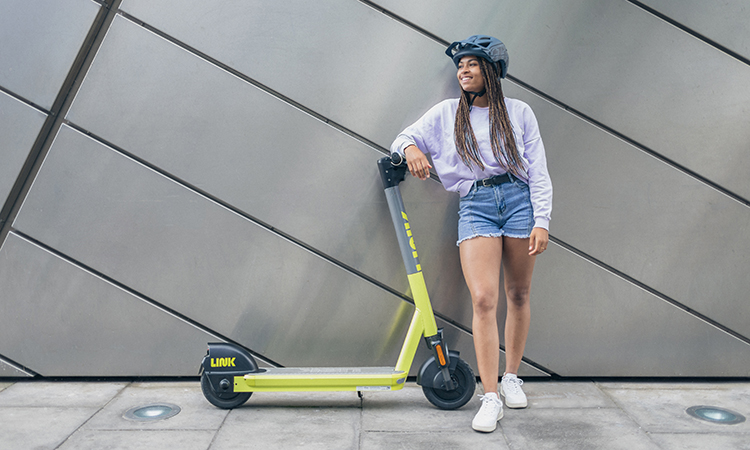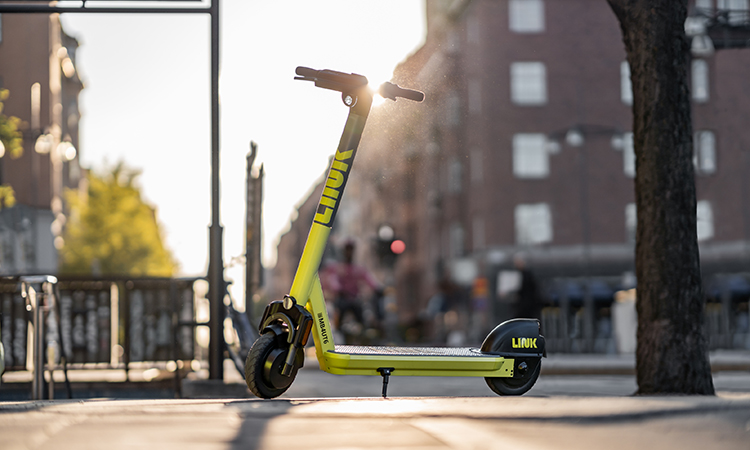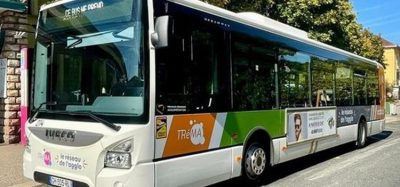Robotics will save the micro‑mobility industry
- Like
- Digg
- Del
- Tumblr
- VKontakte
- Buffer
- Love This
- Odnoklassniki
- Meneame
- Blogger
- Amazon
- Yahoo Mail
- Gmail
- AOL
- Newsvine
- HackerNews
- Evernote
- MySpace
- Mail.ru
- Viadeo
- Line
- Comments
- Yummly
- SMS
- Viber
- Telegram
- Subscribe
- Skype
- Facebook Messenger
- Kakao
- LiveJournal
- Yammer
- Edgar
- Fintel
- Mix
- Instapaper
- Copy Link
Posted: 15 December 2021 | Haya Verwoord Douidri - Superpedestrian | No comments yet
Haya Verwoord Douidri, Vice President (Global Markets and Strategy) at Superpedestrian, explains why the current micro-mobility model is unsustainable, and presents Superpedestrian’s alternative.


Credit: Superpedestrian
There’s no doubt that micro-mobility and its increasing adoption will play a significant role in decarbonising transportation across the world. Unless micro-engineering vehicles are engineered for safety, profitability and accessibility, however, micro-mobility’s growth will be limited. Now is the time to invest significant resources into vehicle engineering and testing, and autonomous safety and maintenance technologies. Micro-mobility providers who fail to do this vital work will be out of the running by 2030.
Unless micro-engineering vehicles are engineered for safety, profitability and accessibility, however, micro-mobility’s growth will be limited”
The impact of micro-mobility to date is evidenced by the remarkable growth of shared e-scooter operators. Estimated to be worth $40 billion in 2020, some forecasts are predicting the global micro-mobility market to grow to as much as $200 billion by 2030. The fastest-growing segment of the shared sector is shared e-scooters, which emerged only four years ago, with Bird and Lime launching in the U.S. in 2017. Within a year, Bird had reached a $1 billion valuation. Both companies were valued at over $2 billion by 2020.
The allure of e-scooters to consumers is most recently illustrated in the UK. Although the vehicles remain illegal to ride on public roads, a small number of trial zones were created in England in the second half of 2020 by the Department for Transport (DfT) to begin gathering data to inform future legislation. By summer 2021, the country’s shared e-scooter fleets were supporting more than one million journeys every month.
But it hasn’t all been good news. Along with colossal valuations and strong ridership came an industry track record of launching without permission, using gig workers and buying off-the-shelf scooters with lifespans measured in just weeks. A period of significant consolidation followed early diversification and, when COVID-19 entered the frame, Lime found itself the subject of a hurried divestment by Uber, and companies such as Bird laid off hundreds of workers overnight. Although later entrants to the market have been careful to avoid antagonising city authorities by launching fleets without permission, the market remains one dominated by unsafe vehicles, shaky economics and even worse labour practices.


Credit: Superpedestrian – Estimated to be worth $40 billion in 2020, some forecasts are predicting the global micro-mobility market to grow to as much as $200 billion by 2030.
The triple challenges of safety, profitability and accessibility
While customer demand looks stronger than ever, three key challenges call into question the future growth and viability of shared e-scooters: firstly, safety (for riders and pedestrians); secondly, profitability (impacted by high maintenance costs, vehicle depreciation, downtime and regulatory risks); and thirdly, accessibility (including in distribution across all parts of a city, deployment in often‑overlooked small towns and vehicles that are comfortable for larger segments of the population). Micro-mobility companies have banked on growth to solve the issues, but history teaches us that this is not the answer. The sobering example of Uber has already proved that simply attracting more customers does not solve regulatory hurdles, and the financial crash of 2007-08 underlines what can happen when short-term growth is prioritised over long-term economic planning.
Safety
The biggest existential threat faced by shared e-scooter operators is safety. The industry has become characterised by an inability to solve persistent problems such as pavement riding, pavement clutter due to misparking and unsafe vehicles that become risks both when riding (e.g. due to a lack of redundant brakes) and charging (e.g. causing battery fires). Failure to address these issues has led to serious injuries and fatalities for both riders and pedestrians.
Without safety improvements, cities will soon run out of patience with e-scooter companies, or operators will succumb to myriad lawsuits”
When the city of Chicago evaluated its 2019 e-scooter trial, authorities concluded that “24 per cent of riders admitted to using the sidewalk at least some of the time,” and “five per cent said they rode on the sidewalk at least half of the time.” In 2021, the situation is no different. Barely a year after a thorough and extensive competitive tender process in Paris, the Deputy Mayor found it necessary to publicly censure the city’s three providers for failing to put a stop to sidewalk riding. Without safety improvements, cities will soon run out of patience with e-scooter companies, or operators will succumb to myriad lawsuits.
Profitability
Micro-mobility companies are also fighting on the front of profitability. By relying on cheaply made scooters that fail fast, margins remain vanishingly low and regular cash injections from investors are required to keep the wheels turning. Billions of dollars have been invested into the sector in the past few years. This model is not sustainable.
Accessibility
Accessibility covers many indicators, but consider just two. In Seattle, the Department of Transportation (SDOT) found that 14.9 per cent of all trips by Superpedestrian riders began or ended in areas of social justice. However, that figure was just 1.4 per cent for the next-highest provider, which is far closer to industry norms. In 2020, just 17.2 per cent of customers who rode scooters from one of the giants of the industry were Black or Latinx. For micro-mobility to truly live up to its lofty ideals, it needs to work for all.
Front-loading R&D to drive success
At Superpedestrian, we realised early on that autonomous safety technologies will be the key to the sector’s survival”
At Superpedestrian, we realised early on that autonomous safety technologies will be the key to the sector’s survival. Rigorous engineering and novel technologies are required to create a vehicle that is safer for riders and pedestrians, and more efficient – and thus profitable – to operate and maintain over the long-term. Today, most shared micro-mobility companies view their e-scooters as cheap, disposable commodities. The businesses that succeed, however, will be those that invest in advanced vehicles technologies. This is an approach that we are pioneering at Superpedestrian – and it’s working. Now in over 50 cities, our global fleet has achieved an unparalleled safety record unmarred by the recalls, systemic failures and preventable crashes that have dogged other operators. For example, our e-scooter uses five onboard microcomputers and nearly 80 sensors to run 1,000 health checks every second during a ride. And by combining hyper‑accurate positioning, motion sensors and our patented onboard geofencing, we’ve created the first e-scooter that knows when it’s on a footpath and shuts down the ride automatically – the biggest single step towards keeping pedestrians safe, as well as our riders.


Credit: Superpedestrian – Superpedestrian’s LINK e-scooters use five onboard microcomputers and nearly 80 sensors to run 1,000 health checks every second during a ride.
While safety was our number one concern when developing our sophisticated e-scooter, better unit economics are a direct consequence. To explain: Superpedestrian’s LINK scooter senses when components are being stressed beyond normal operating conditions and moderates its own performance to prevent failures. This greatly reduces the number of expensive parts that we have to replace, including motors and batteries. By running health-checks prior to every ride, and every 30 minutes between rides, the LINK scooter introduces predictive maintenance, which greatly improves vehicle up-time. In the event of a problem that can’t be corrected autonomously, vehicle self‑diagnosis reduces maintenance labour, bringing further benefits to the bottom line. Added together, these factors have cut our operating costs by 70 per cent compared to industry norms, allowing us to become profitable at a much lower rider threshold, in smaller towns and in ‘tough’ neighbourhoods. We are, of course, not alone in designing technologies to improve safety and profitability, but we’ve had a significant head start thanks to our MIT roots. Our patent portfolio, which is twice the size of the rest of the sector combined, will stand our business in good stead over the next decade. Accessibility requires a more holistic approach, but the vehicle is still the biggest single factor. Carefully considering the form of the vehicle itself – catering for a range of weights, heights, ages and so on – makes it more usable by a wider spectrum of population. Long-range batteries enable efficient deployment to outer suburbs and in small towns to better connect all communities. Targeted deployment ensures that areas of deprivation and ethnically diverse centres are included. Superpedestrian’s operating experience in 50 towns and cities across eight countries – including two towns with populations of just 15,000 people – proves conclusively that this approach works.
Rise of the robots
Over the next decade, most Western countries will introduce national legislation to govern the quality and safety of shared micro-mobility. In the same way that car manufacturers are no longer permitted to sell vehicles without seatbelts, by 2030, micro-mobility companies will not be invited to operate sharing programmes without automated safety technologies. Robotics and artificial intelligence (AI) are only just beginning to impact shared micro-electric vehicles, but the pace of technological innovation in the sector is breath-taking, thanks in part to companies like Superpedestrian. The next 10 years in micro-mobility will be the most exciting yet.
Haya Verwoord Douidri is Vice President (Global Markets and Strategy) at Superpedestrian, a world-leader in transportation robotics and human-scale mobility. In her first 12 months at the company, Superpedestrian introduced shared mobility services with its intelligent e-scooter, LINK, to 50 cities across eight countries.
A frequent keynote speaker on shared mobility and transport innovation, Douidri holds a Masters’ Degree in sustainable policy from Columbia University. She has worked on sustainability projects at the United Nations (UN) and Shell, and she was instrumental in shaping European activities for micro-mobility company Bird. Douidri has worked in more than 20 countries on four continents and speaks eight languages.
Related topics
Artificial Intelligence, Connected & Autonomous Vehicles, COVID-19, Fleet Management & Maintenance, Mobility Services, On-Demand Transport, Passenger Experience, Sustainable Urban Transport, Vehicle & Passenger Safety
Issue
Issue 4 2021
Related modes
Bikes & Scooters
Related organisations
Bird, City of Seattle Department of Transportation (SDOT), Department for Transport (DfT), Lime, Superpedestrian, Uber
Related people
Haya Verwoord Douidri








